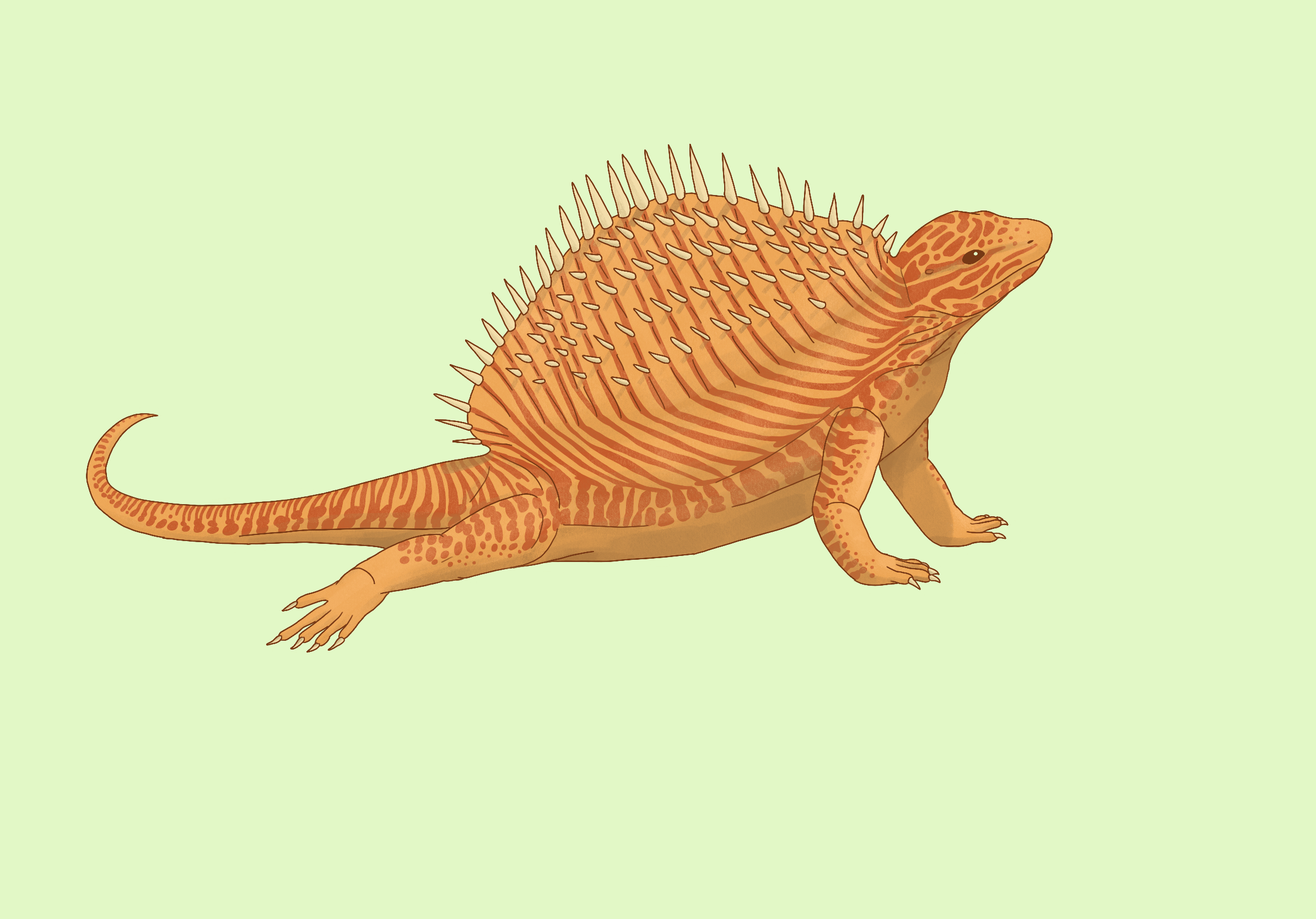In this post, I’m going to summarize the history of complex life on earth, starting with the Ediacaran period and ending in the present day. In each section, I’ll list some notable creatures and take a look at what the ancestors of humans and the ancestors of birds looked like at that time. Buckle your seatbelts!
The Neo-Proterozoic Era (1000-541 million years ago)
The Neo-Proterozoic is the last era in the Proterozoic Eon, and the Ediacaran Period is the last period in the Neo-Proterozoic Era. It was in the Ediacaran that the first fossils of plants and animals large enough to see with the naked eye become abundant, in what is now known as the Ediacaran Biota. Before that, microscopic life existed, but that’s a whole ‘nother story that we’ll skip over for now.
The Ediacaran Period: The first animals (635-541 million years ago)
The earliest visible fossils come from the Ediacaran Period (pronounced ee-dee-ACK-rin), when most creatures were sessile (couldn’t move) and thick mats of bacteria covered the seafloor. By the end of the period, motile (moveable) creatures like Spriggina and Kimberella crawled or swam and may have even hunted for food.
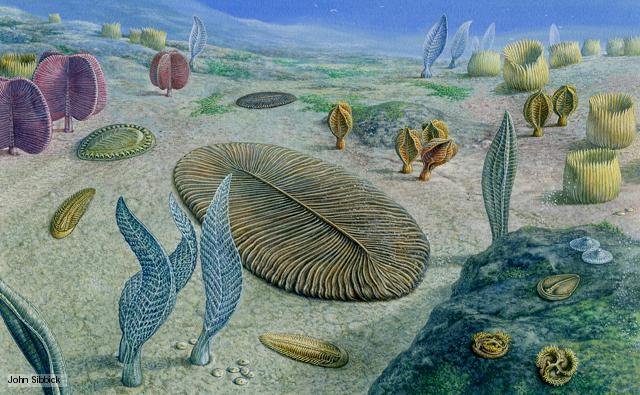
The Ediacaran Biota. Pictured: Dickcinsonia (front and center), Charnia (the bluish quill pens), Spriggina (the small yellow guys), Kimberella (the green blob behind Dickinsonia), Tribrachidium (bottom right corner), Swartpuntia (red quill pens), and some others. Note that all these depictions are highly speculative; here, Spriggina is depicted as crawling along the seafloor, but it may have been a free-swimming creature, or it may even have actually been a frond-like creature, rooted to the ground by the “head” end. Here, Tribrachidium is depicted as an echinoderm-like creature stuck to a rock, but in reality it may have been a holdfast for a frond as well. There is a lot we don’t know about these strange creatures.
Notable creatures:
- Microbial mats covered much of the seafloor
- Frond-like sessile creatures:
- Dickinsonia
- Charnia
- Haootia
- Motile invertebrates:
- Kimberella
- Spriggina
What did our ancestors look like?
Haootia, a cnidarian polyp, was the first known creature with muscles. Our ancestors probably resembled it.
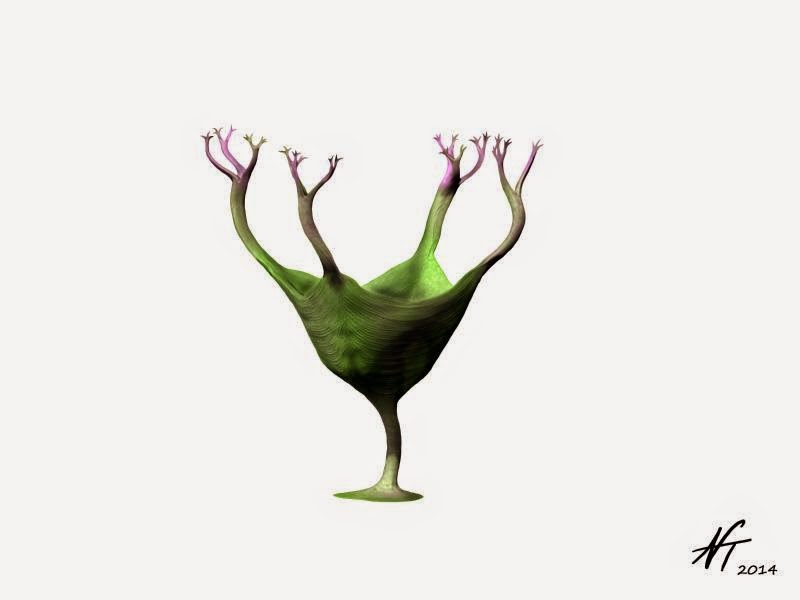
The Paleozoic Era (541-251.9 million years ago)
The next six geologic periods fall within the Paleozoic Era. A ton of stuff happened during this era; at the beginning, small, primitive jawless fish and arthropods killed each other on the seafloor, and at the end, large, advanced, saber-toothed stem-mammals killed each other on land. In between, giant sea scorpions, giant armored fish, and giant terrestrial bugs each enjoyed a heyday before giving way to the next wave of extinction and subsequent innovation.
The Cambrian Period: The Cambrian Explosion (541-485.4 million years ago)
At the end of the Ediacaran period, animals developed mouths and guts that gave them the ability to eat and hunt rather than just sitting atop the microbial mats and passively absorbing nutrients. To avoid being hunted, creatures began to burrow into the sediment, disturbing the ocean chemistry and destroying the thick microbial mats that covered the seafloor, causing the creatures that depended on them to go extinct. What soon replaced them was a huge variety of creatures with exotic body plans no longer seen today, in a radiation event known as the Cambrian Explosion. One factor that may have helped accelerate the Cambrian Explosion was invention of eyes, which enabled animals to hunt each other and avoid each other, putting natural selection pressure on overdrive. During this period, chordates (animals with a primitive backbone) first arose, such as the eel-like Pikaia and the fish-like Haikouichthys.
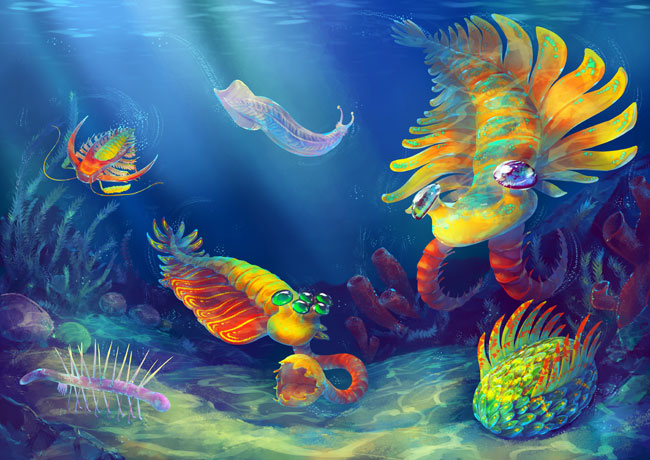
Notable creatures
- First chordates
- Pikaia
- Conodonts
- Haikouichthys
- Tunicates, also known as sea squirts, are still alive today. Some people eat them in the form of “sea pineapple”.
- Didazoon, a swimming vacuum hose
- Very strange invertebrates
- Anomalocaris, the first apex predator
- Opabinia, with a long mobile mouth tentacle thing and five eyes
- Wiwaxia, what the Pokemon Pyukumuku is based on
- Diania, the walking cactus
- Hallucigenia, the famous spiky worm that was first reconstructed upside-down and backwards
- Trilobites
What did our ancestors look like?
Many modern polyp-like creatures are free-swimming in their childhood and have primitive backbone-like structures, before taking root as an adult. At some point in the Cambrian, one of our polyp ancestors didn’t grow up, instead staying free-swimming as an adult, and became the first chordates, like Pikaia. In the later Cambrian, chordates diversified and became more advanced–Haikouichthys, a jawless fish, was one of the first craniates (animals with a skull and true backbone).
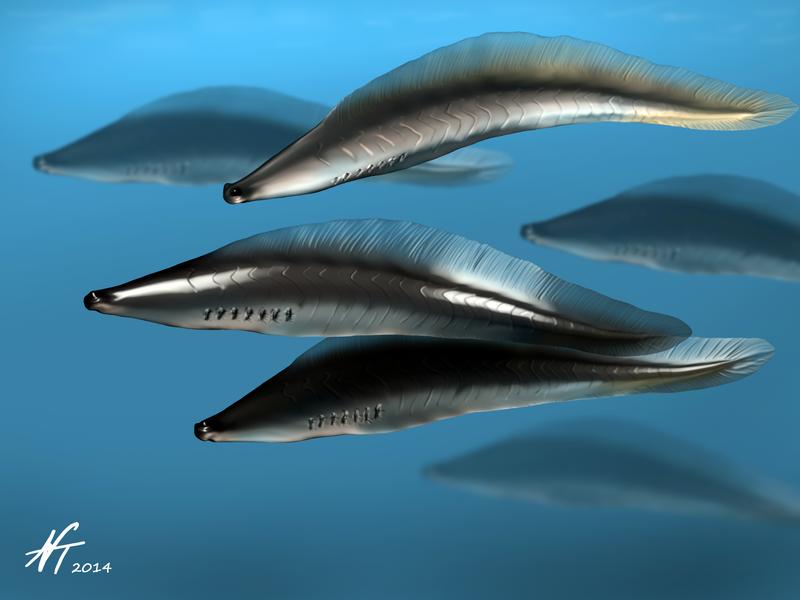
The Ordovician Period: The Great Ordovician Biodiversification Event (485.4-443.8 million years ago)
After another series of extinctions wiped out many of the strangest of the Cambrian animals, fish, molluscs, and arthropods replaced them and became prominent, in another radiation event called the Great Ordovician Biodiversification Event. Large arthropods called eurypterids, or sea scorpions, prowled the oceans as apex predators–some, like Pentecopterus, were bigger than a man. Meanwhile fish grew armor but remained jawless filter-feeders, and shelled molluscs, which looked similar to today’s nautiluses, became common.

Notable creatures
- Jawless, armored fish (agnathans)
- Sacabambaspis
- Arandaspis
- Molluscs
- Cameroceras
- Endoceras
- Eurypterids
- Pentecopterus
- Eocarcinosoma
- First land plant spores (bryophytes)
What did our ancestors look like?
Jawless fish were now clearly true fishes, and began to develop bony armored plates, especially on their heads. Sacabambaspis was one such armored fish–think swimming Nerf football.
The Silurian Period: The first jawed fish; also tree-sized fungi (443.8-419.2 million years ago)
So far, the oceans have been very busy, while land has remained nearly empty of living things. This was because there was no soil, only rocks, so plants that depend on soil couldn’t go on land, and animals that depend on plants couldn’t either. But during the Silurian, a giant spear-shaped fungus called Prototaxites bravely colonized the land, breaking down the inhospitable rocks into welcoming soil. Early plants like Cooksonia soon followed, as well as pioneering arthropods such as Trigonotarbida. Meanwhile, in the seas, sea scorpions continued to grow and dominate, while fish developed jaws.
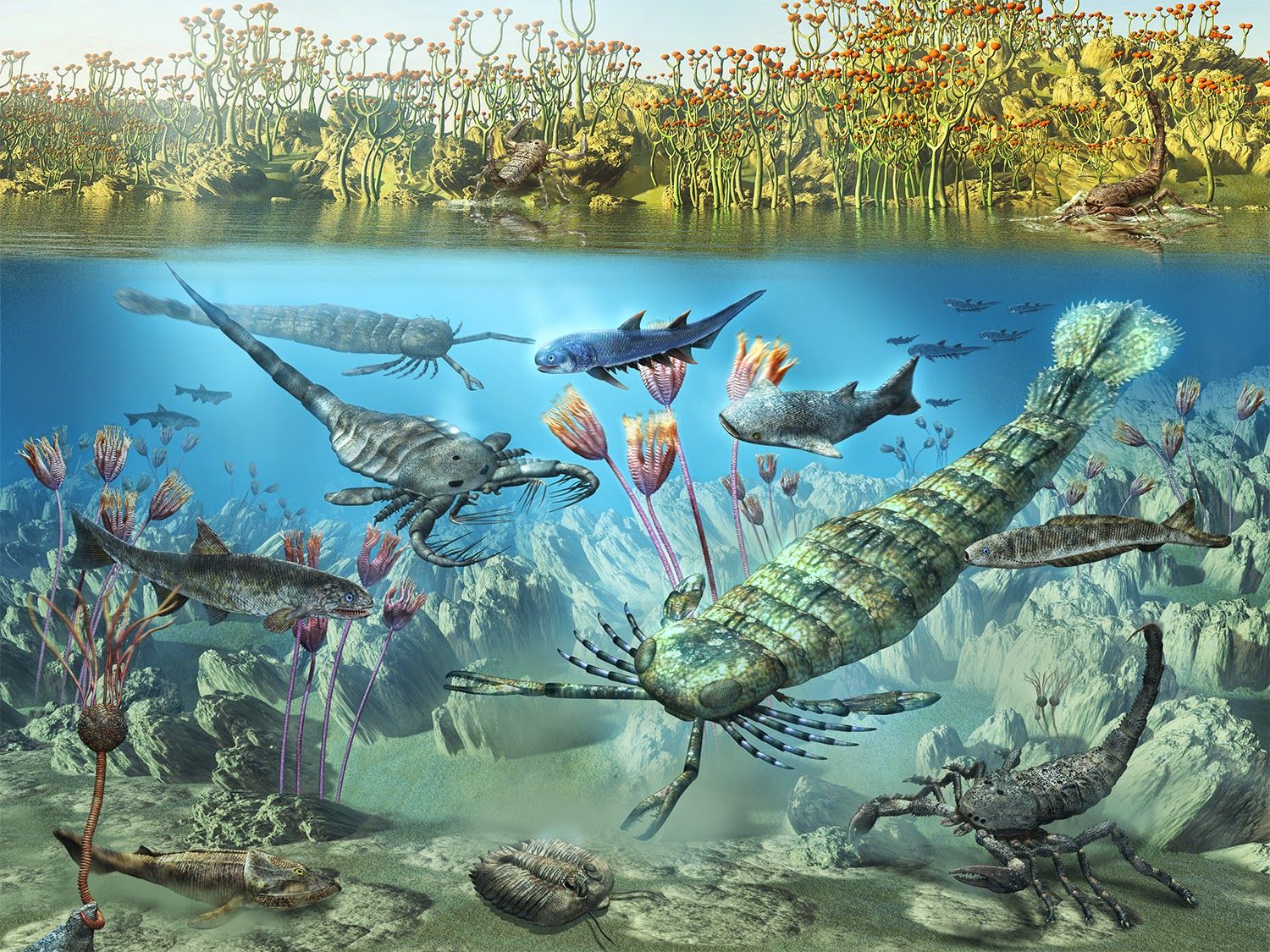
Notable creatures
- In the water:
- Larger eurypterids
- Eurypterus
- Pterygotus
- More armored, jawless fish
- Dunyu
- Ateleaspis
- First sharks (jawed, cartilaginous fish)
- Elegestolepis
- Nerepisacanthus
- Early placoderms (armored, jawed fish)
- Silurolepis
- Entelognathus
- Early lobe-fined fish (sarcopterygii)
- Psarolepis
- Megamastax
- Guiyu
- Larger eurypterids
- On land:
- Prototaxites
- Cooksonia
- Trigonotarbida
What did our ancestors look like?
The first jawed fish quickly split into three groups: the placoderms (armored fish, now extinct), the osteichthyes (bony fish, including us), and the chondrichthyes (cartilaginous fish, including sharks). The bony fish further split into the actinopterygii (ray-finned fish, including most modern fish; pronounced “ACT-in-OP-ter-EE-jee-ai”) and the sarcopterygii (lobe-finned fish, including us; pronounced “sar-COP-ter-EE-jee-ai”). An early example of a lobe-finned fish was Guiyu. Now our lineage has diverged from that of sharks and other fish, but we still share an ancestor with modern lobe-finned fish such as coelacanths and lungfish.
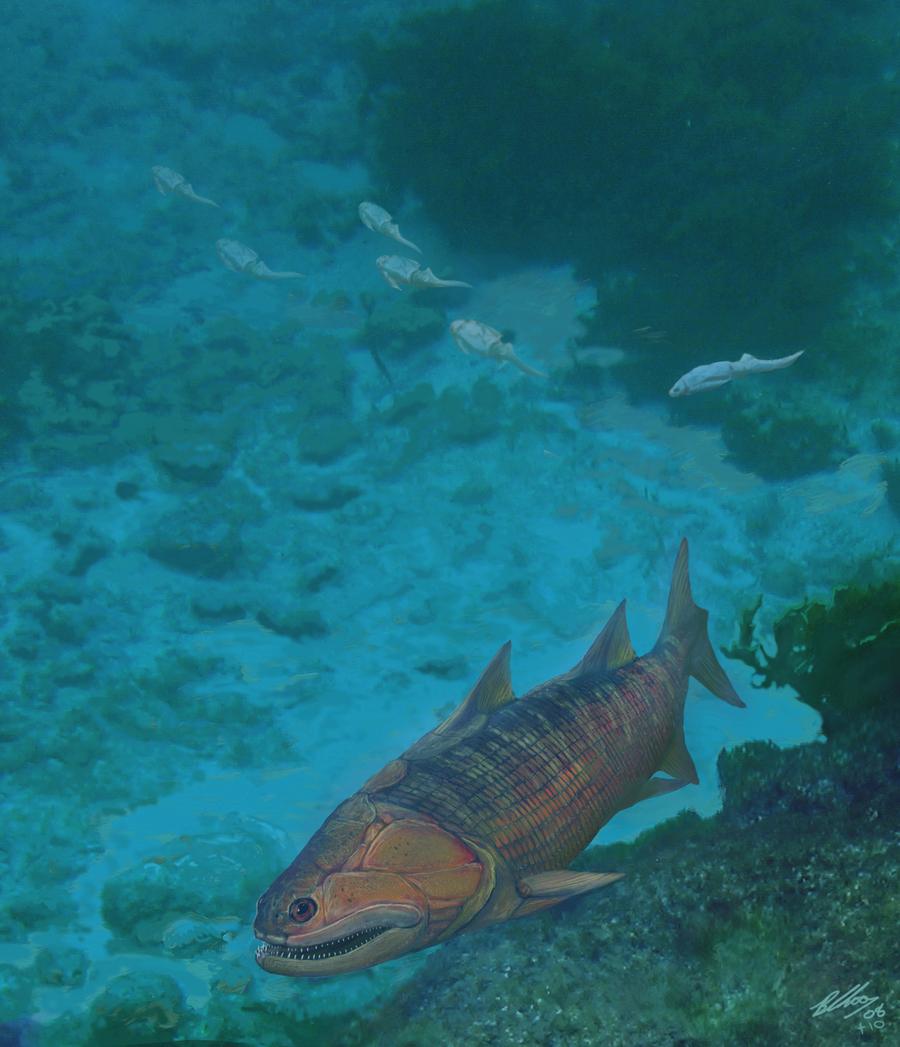
The Devonian Period: The Age of Fishes (419.2-358.9 million years ago)
Things were getting really exciting in the ocean, with the advent of giant predatory placoderms such as Dunkleosteus, a fish the size of a car! Early tetrapodomorphs (four-limbed creatures) like Tiktaalik and Ichthyostega could breathe air and ventured up onto land.
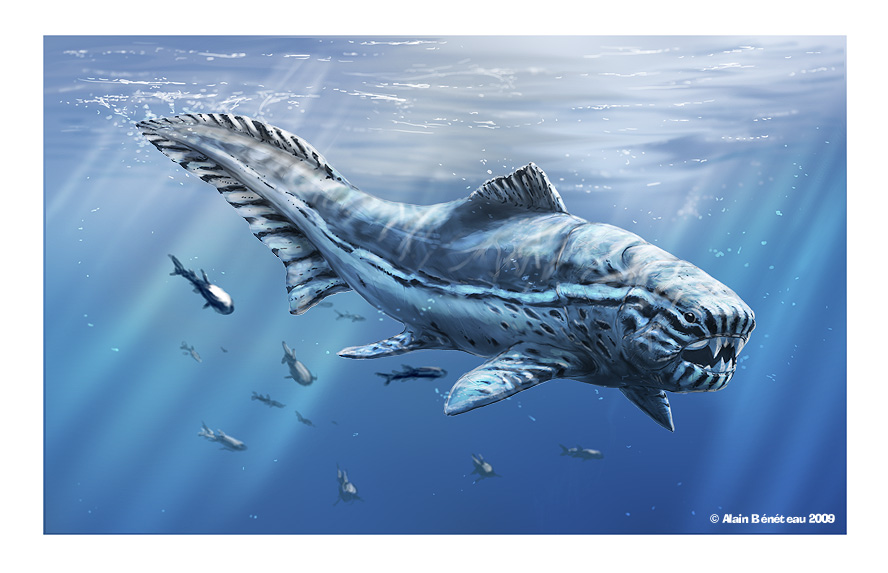
Notable creatures
- In the water:
- Giant placoderms rule the seas
- Dunkleosteus
- Titanichthys
- Strange sharks
- Edestus, the scissor-jawed shark
- Stethacanthus, the anvil-headed shark
- Antarctilamna, the unicorn shark
- Giant eurypterids–the biggest arthropods to ever live
- Jaekelopterus
- Adelophthalamus
- Ammonites
- Giant placoderms rule the seas
- First tetrapods–early amphibians
- Tiktaalik
- Acanthostega
- Ichthyostega
What did our ancestors look like?
Early in the Devonian, “fishapods” like Tiktaalik lived mostly in the water, but sometimes ventured onto land. Later on, tetrapods’ teeth, legs, and feet developed further until something like Ichthyostega could live primarily on land and walk without dragging its belly. By now, our lineage has split from that of other modern lobe-finned fish such as coelacanths and lungfish, but we still share a common ancestor with amphibians.
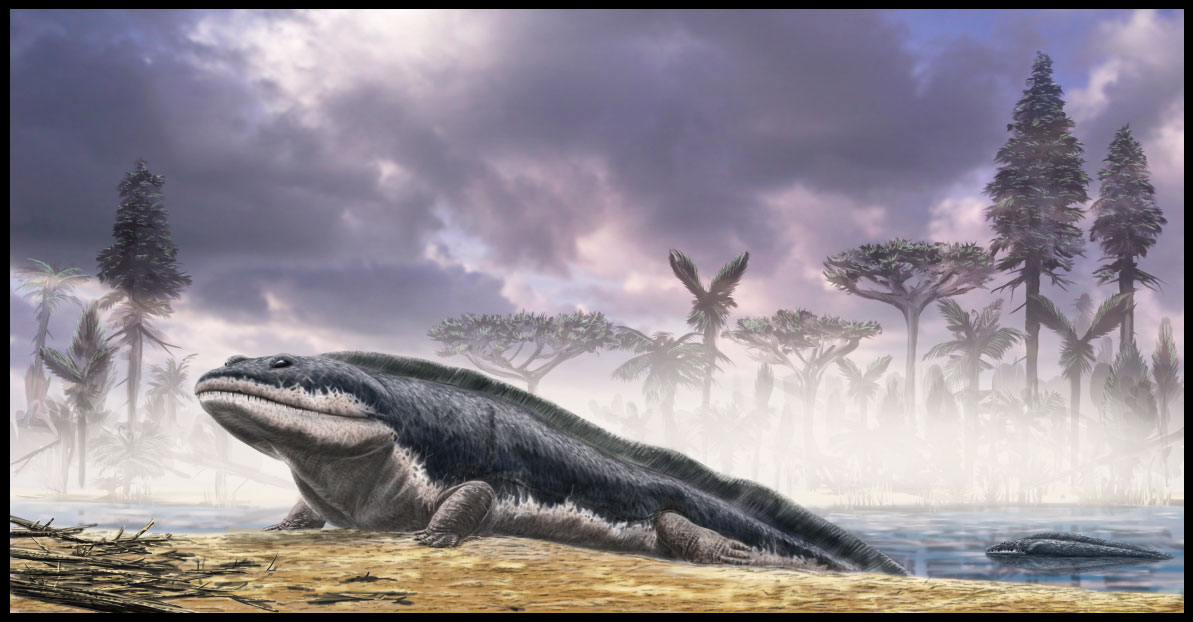
The Carboniferous Period: The Age of Giant Bugs (358.9-298.9 million years ago)
During the Carboniferous, the first trees, such as Lepidodendrales, emerged and quickly spread to cover the planet. However, unlike today, wood did not decompose, since nothing had figured out how to eat it yet. So, the trees absorbed carbon dioxide and pumped more and more oxygen into the atmosphere, but when they died, they didn’t release carbon dioxide during decomposition like they do today. Because of this, the oxygen level in the air soared, and arthropods, which breathe through their exoskeletons, were able to become bigger than ever before or ever since.
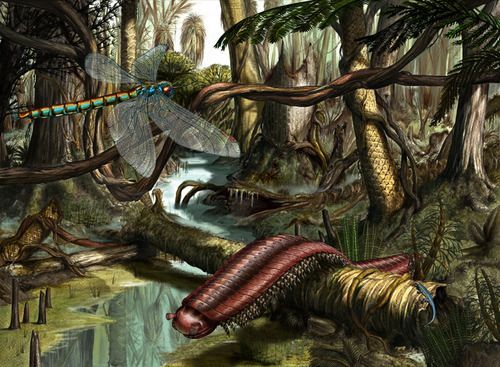
Notable creatures
- Sauropsids (ancestors of reptiles)
- Hylonomus
- Petrolacosaurus
- Synapsids (ancestors of mammals)
- Ianthasaurus
- Sphenacodon
- Giant arthropods
- Meganeura, a dragonfly the size of a crow
- Arthropleura, a millipede the size of an alligator
- Pulmonoscorpius, a terrestrial scorpion the size of a cat
- Tully Monster, a mysterious creature whose affinity is still uncertain (update: we now think it’s probably a jawless fish!)
- Lepidodendrales, the tree that took over the world (and now forms a significant fraction of our fossil fuel deposits)
What did our ancestors look like?
The first amniotes appeared at this time–animals who used waterproof eggshells that allowed them to lay their eggs on land. Reptiles, birds, and mammals are modern amniotes. Soon after this innovation, the sauropsids split from the synapsids. So now we have different ancestors than the bird line: our ancestors looked like Sphenacodon, while birds’ ancestors looked like Petrolacosaurus.
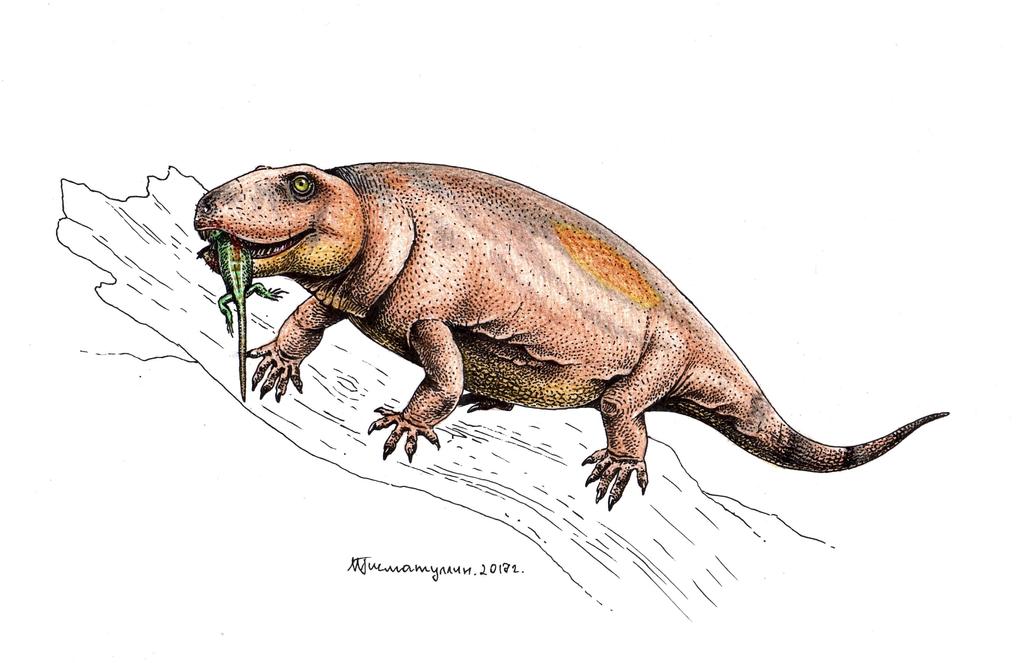
The Permian Period: Amniotes Rule, aka Age of ‘Mammals’ 1.0 (298.9-251.9 million years ago)
At the end of the Carboniferous, all the continents smashed together into one supercontinent called Pangaea. This meant a lot of the land area was now farther from the water, which caused huge deserts to form where there used to be rainforests in an event called the Carboniferous Rainforest Collapse. Since there were less trees, oxygen levels also fell. Amniotes were able to live in this new dry environment, and quickly replaced the water-dependent amphibians and oxygen-dependent arthropods that used to be in charge. By the end of the Permian, synapsids were the most diverse and successful group, filling a wide variety of niches.
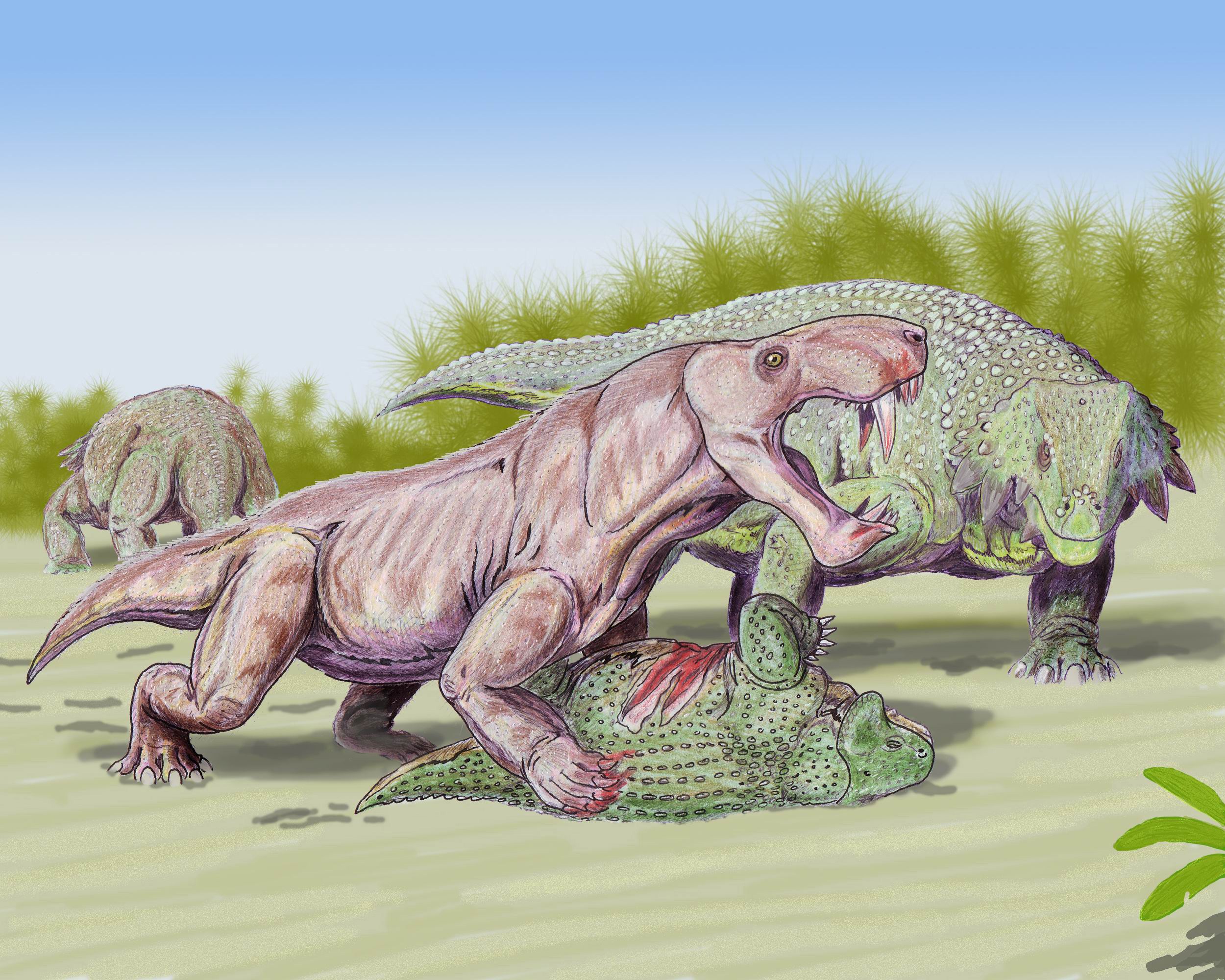
Notable creatures
- Synapsids
- Dimetrodon, an apex predator with an impressive sail on its back
- Edaphosaurus, a large herbivore with an impressive sail on its back
- Gorgonops, an apex predator with saber teeth
- Sauropsids
- Archosaurus, an early archosaur
- Bradysaurus, an herbivorous pareiasaur
- Temnospondyls
- Prionosuchus, a crocodile-sized amphibian
- Platyhystrix, an amphibian with an impressive sail on its back. Apparently these were very fashionable.
- Helicoprion, the whorl-toothed shark
What did our ancestors look like?
Mammals and reptiles continued to become more mammalian and reptilian, respectively. During this period, the lineage of archosaurs (ancestors of crocodylians, dinosaurs, and birds) split from that of the rest of the reptiles. Our Permian ancestor looked like Procynosuchus, while birds’ looked like Protorosaurus.
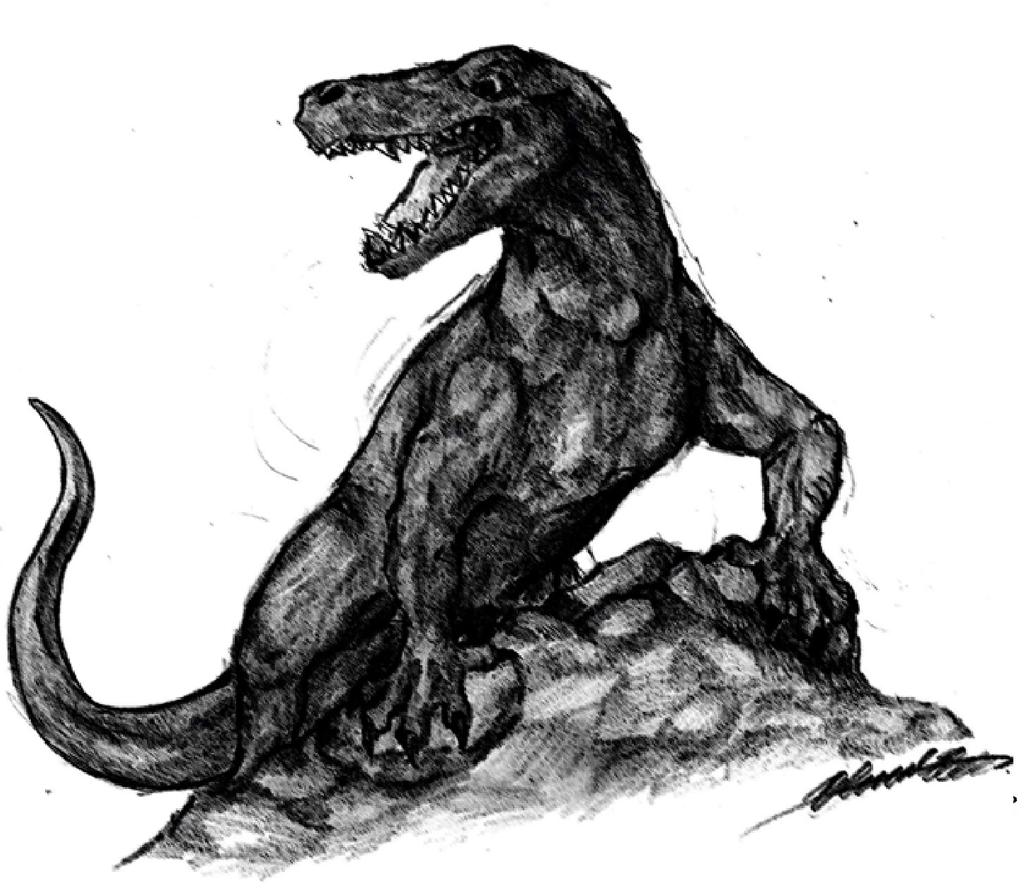
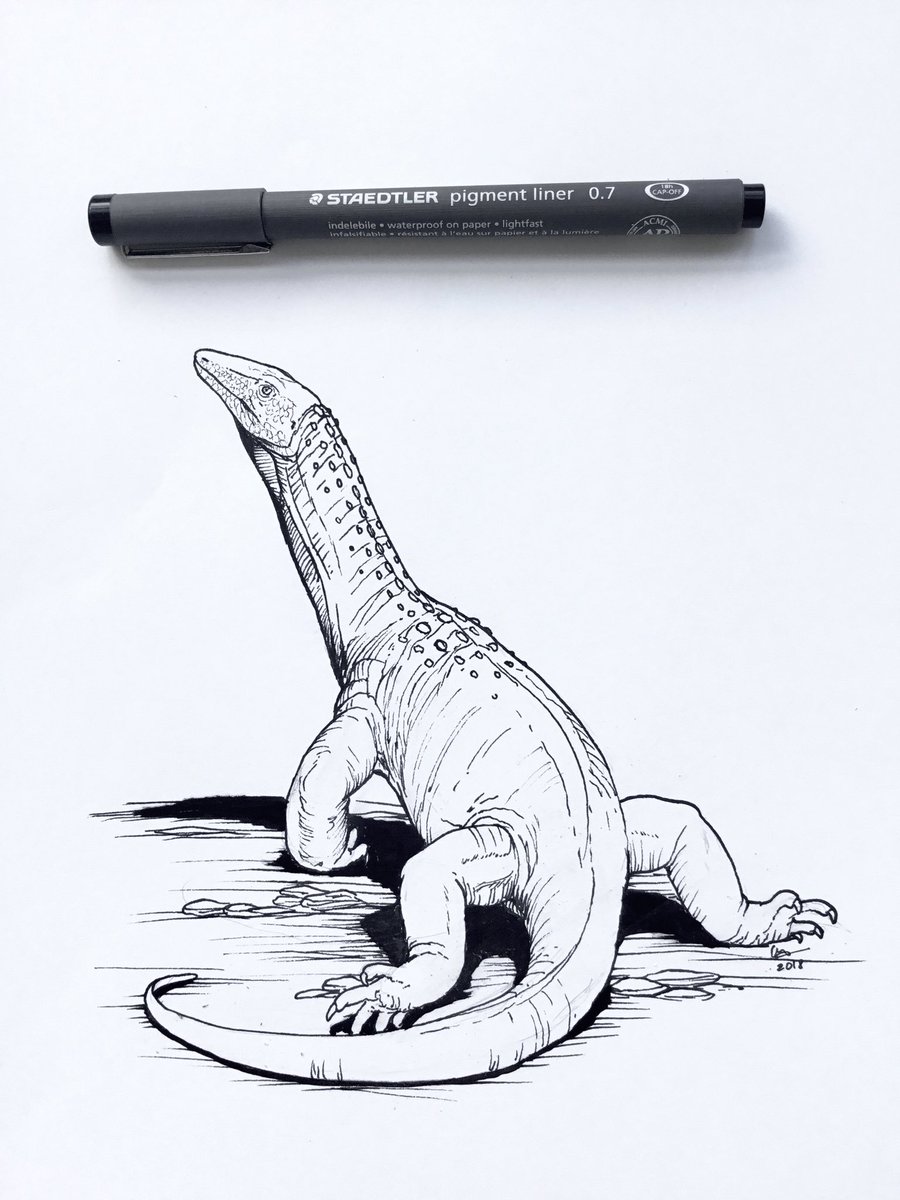
The Mesozoic Era: Age of Reptiles (251.9-66 million years ago)
The next three geologic periods fall within the Mesozoic Era, which saw the rise and fall of the dinosaurs, the first true birds, and the first angiosperms (flowering plants). Dinosaurs didn’t look like the front-runners in the Triassic, but the extinction that ended that period pushed them into the spotlight. The Mesozoic ended with the famous K-Pg (Cretaceous-Paleogene) asteroid impact that killed all the non-avian dinosaurs.
The Triassic Period: More weirdness and experimentation - herbivorous crocodiles? (251.9-201.3 MYA)
The end of the Permian period was marked by the worst mass extinction Earth has ever seen, known as the Great Dying. It took a very long time for life to recover, but once it did, it was very different from before. Reptiles had become the dominant land creature, while mammals became tiny and mostly took a backseat. There were many types of strange crocodylians, from the terrifying long-legged apex predator Fasolasuchus to the tiny herbivorous “pug croc” Revueltosaurus. Late in the Triassic, early sauropodomorphs (ancestors of long-necked dinosaurs) and early theropods (carnivorous dinosaurs) appeared and rose to prominence following the Carnian Pluvial Event.
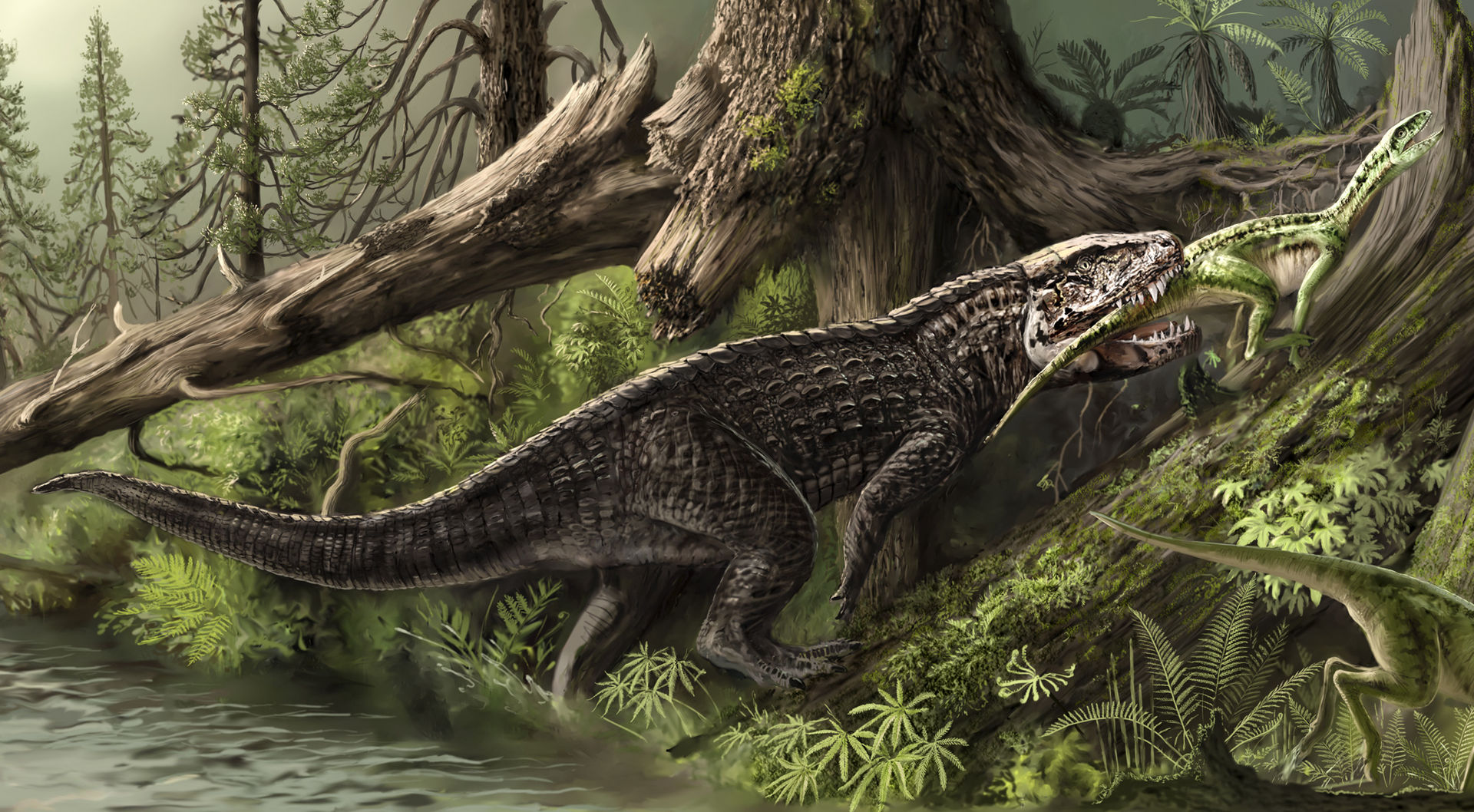
Notable creatures
- Crocodylians
- Postosuchus, a quadrupedal Tyrannosaurus-lookalike
- Lotosaurus, a sail-backed, herbivorous, beaked croc (he didn’t get the memo that sails went out of style after the Permian)
- Effigia, a croc pretending it’s a dinosaur
- Early dinosaurs
- Eoraptor
- Coelophysis
- Plateosaurus
- Strange reptiles
- Tanystropheus, a living fishing rod
- Drepanosaurus, a chameleon mimic
- Sharovipteryx, a reptile with wings on its legs??
- Giant ichthyosaurs
- Shonisaurus
- Shastasaurus
- Early pterosaurs
- Eudimorphodon
- Caviramus
What did our ancestors look like?
During this time, archosaurs split into pseudosuchians (including crocodylians) and pan-aves, meaning “all birds” (including dinosaurs and pterosaurs). Our Triassic ancestor resembled the rat-like Morganucodon, while birds’ ancestor looked like Tawa, a carnivorous theropod dinosaur. Tawa probably had protofeathers, but it didn’t have wings–the feathers were for keeping warm and for display.
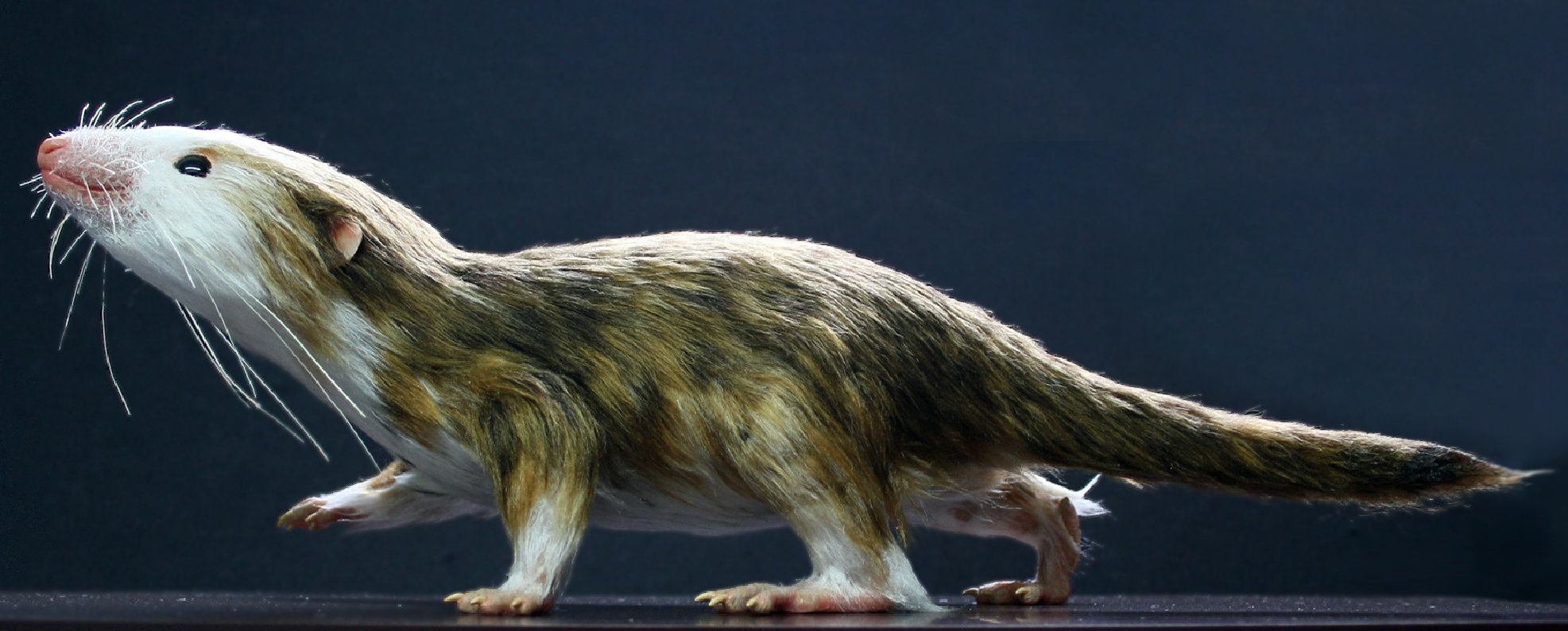
The Jurassic Period: Dinosaurs really hit their stride (201.3-145 million years ago)
The Triassic period ended with another mass extinction, which wiped out much of the dinosaurs’ competition and cleared the way for them to become dominant. They expanded into a wide variety of ecological niches, from the plate-backed, herbivorous Stegosaurus to the bird-like Archaeopteryx to the giant carnivore Allosaurus. Marine reptiles also diversified, with the famous Nessie-like Plesiosaurus, big-mouthed pliosaurs like Liopleurodon, and dolphin-like ichthyosaurs ruling the seas.
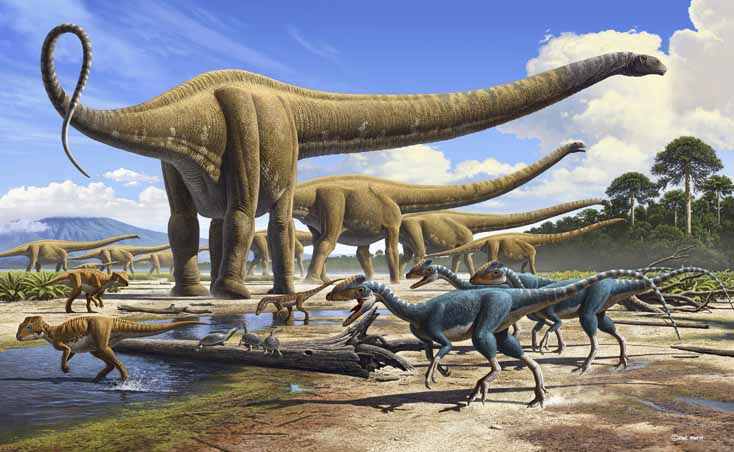
Notable creatures
- Dinosaurs
- Theropods
- Dilophosaurus, which probably did not spit poison
- Allosaurus
- Compsognathus
- Archaeopteryx
- Sauropods
- Diplodocus
- Brachiosaurus
- Apatosaurus
- Ornithischians
- Stegosaurus
- Fruitadens
- Theropods
- Marine reptiles
- Plesiosaurus
- Ichthyosaurus
- Liopleurodon
- Pterosaurs
- Dimorphodon
- Pterodactylus, which is much tinier than you imagine
- Leedsichthys, the largest fish to ever live
What did our ancestors look like?
Our Jurassic ancestor looked like Docodon, another rodent-like early mammal, while birds’ ancestor looked like Archaeopteryx, a dinosaur. Archaeopteryx shared certain traits with modern birds, such as feathers, wings, and flight, but certain traits were still basal, such as a long stiff tail and lack of a keratinous beak. Now the lineage of birds has split from that of the non-avian dinosaurs.
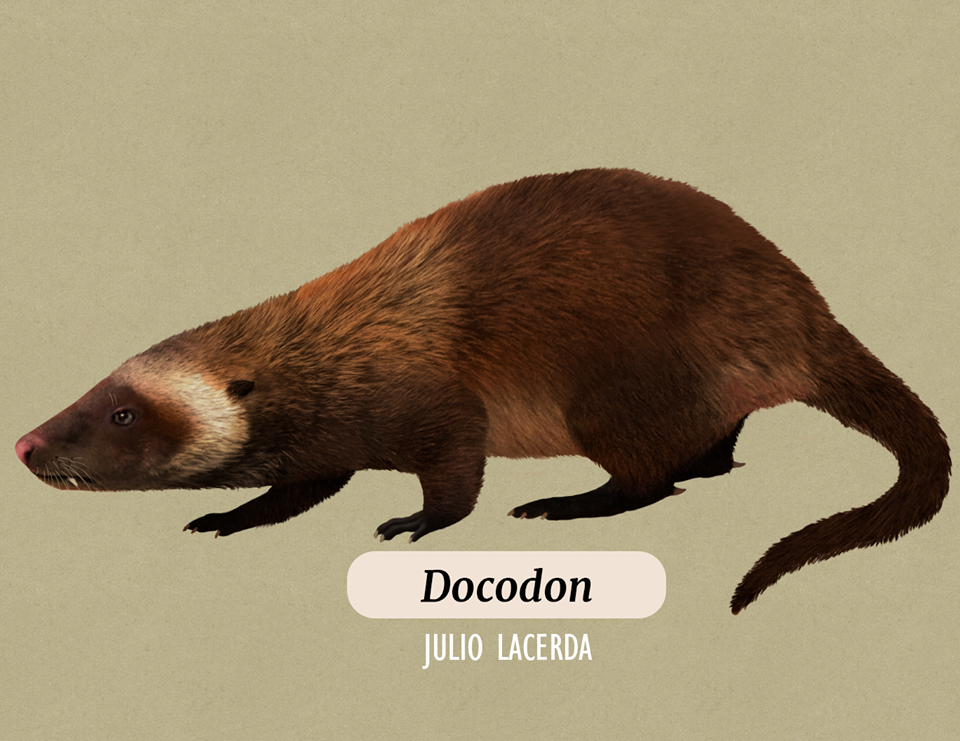
The Cretaceous Period: Dinosaurs get really cool (145-66 million years ago)
Unlike the Permian and the Triassic, which ended with mass extinctions, the Jurassic slid unnoticeably into the Cretaceous as dinosaurs continued to become more derived. In addition to crowd favorites such as Ankylosaurus, Triceratops, Tyrannosaurus, and Velociraptor, there were unusual creatures like Spinosaurus, a sail-backed semiaquatic predator, and Carnotaurus, a bull-horned, short-faced predator. Azhdarchid pterosaurs ruled the skies–Quetzalcoatlus was as big as a giraffe!–and mosasaurs, giant aquatic lizards, ruled the seas.
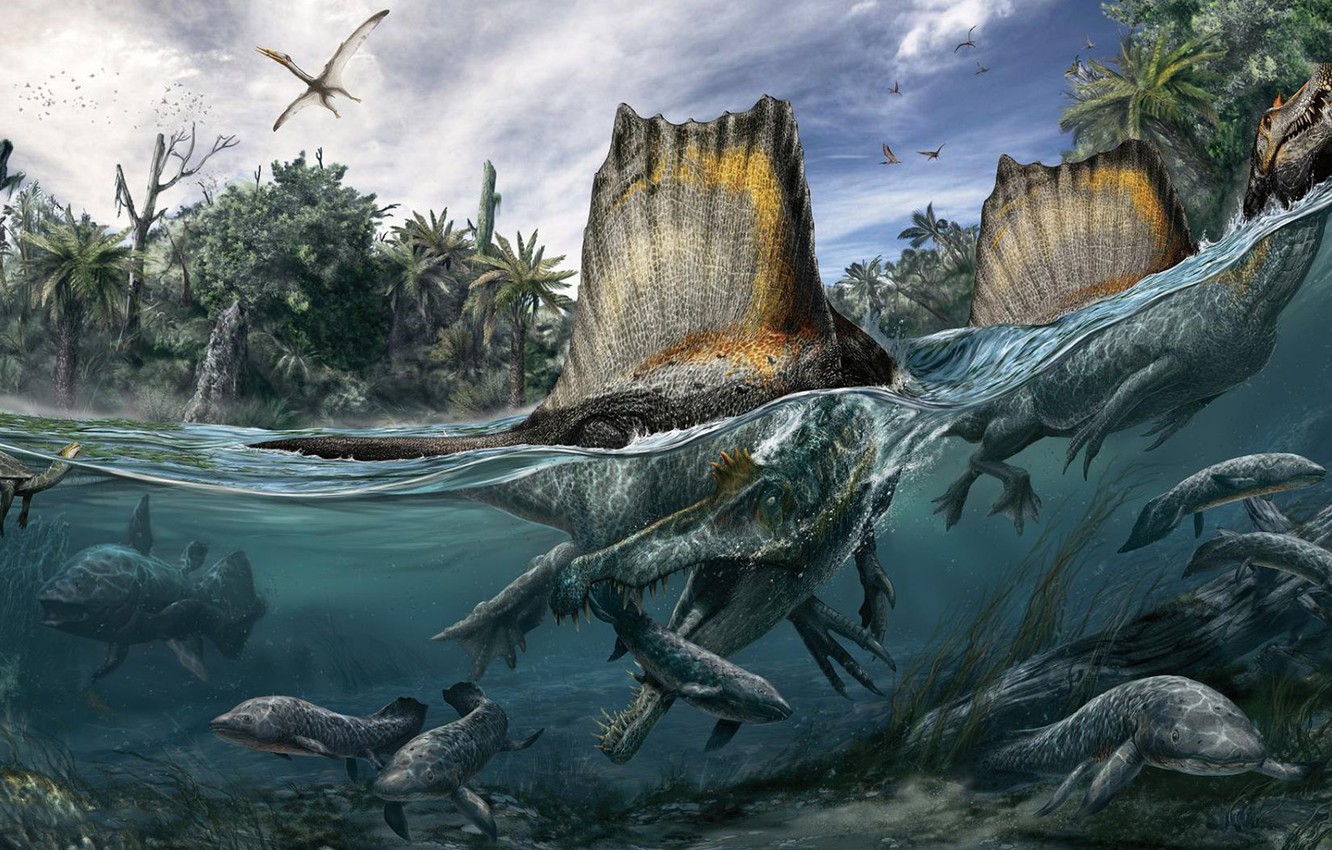
Notable creatures
- Dinosaurs
- Theropods
- Spinosaurus, bringing the sail back
- Tyrannosaurus
- Carnotaurus
- Velociraptor
- Oviraptor
- Sauropods
- Patagotitan, possibly the largest land animal ever to live
- Alamosaurus
- Ornithischians
- Ankylosaurus
- Triceratops
- Pachycephalosaurus, the dome-headed dinosaur
- Parasaurolophus, the Elvis-crested ornithopod
- Theropods
- Pterosaurs
- Pteranodon
- Quetzalcoatlus
- Marine creatures
- Elasmosaurus
- Archelon, a giant sea turtle
- Mosasaurus, an aquatic apex predator related to monitor lizards
- Cretoxyrhina, an impressive shark
- Xiphactinus, a giant predatory fish
What did our ancestors look like?
Our Cretaceous ancestor resembled Zalambdalestes, a eutherian mammal. That means our lineage has split from that of metatherians (including marsupials) and monotremes (egg-laying mammals). Birds’ Cretaceous ancestor looked like Ichthyornis, a true bird, which by now had developed a keratinous beak and reduced tail, but its beak still contained teeth.
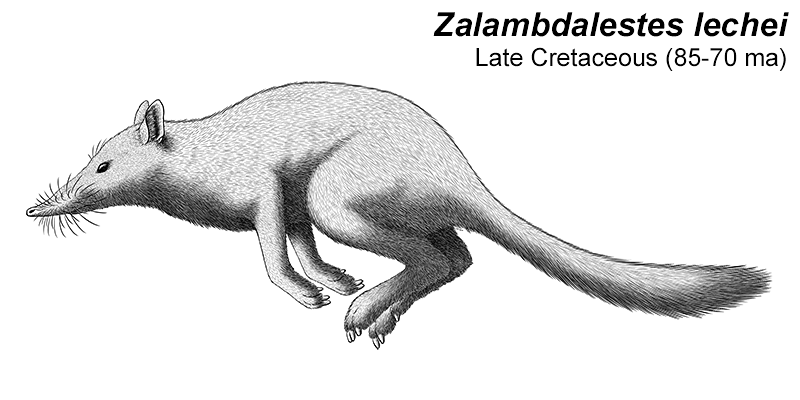

The Cenozoic Era: Age of Mammals 2.0 (66 million years ago - present)
After the dinosaurs were wiped out, mammals, which had been mostly eking out a living as small, unobtrusive burrowers and scavengers during the Mesozoic, quickly diversified to fill the open niches. As always following a mass extinction, there was some weirdness and experimentation in the early part of the Cenozoic, but even then the world looked pretty comparable to how it does today.
The Paleogene Period: Age of Ungulates (66-23 million years ago)
The reign of the dinosaurs ended with a single Very Bad Day, when a giant asteroid smashed into Mexico. This created an opening for other creatures to diversify and fill the empty niches. Axe-faced giant birds such as Gastornis became apex predators in South America, while the giant pig-like Andrewsarchus terrorized Asia. Early ancestors of whales, horses, primates, and dogs also became recognizable.
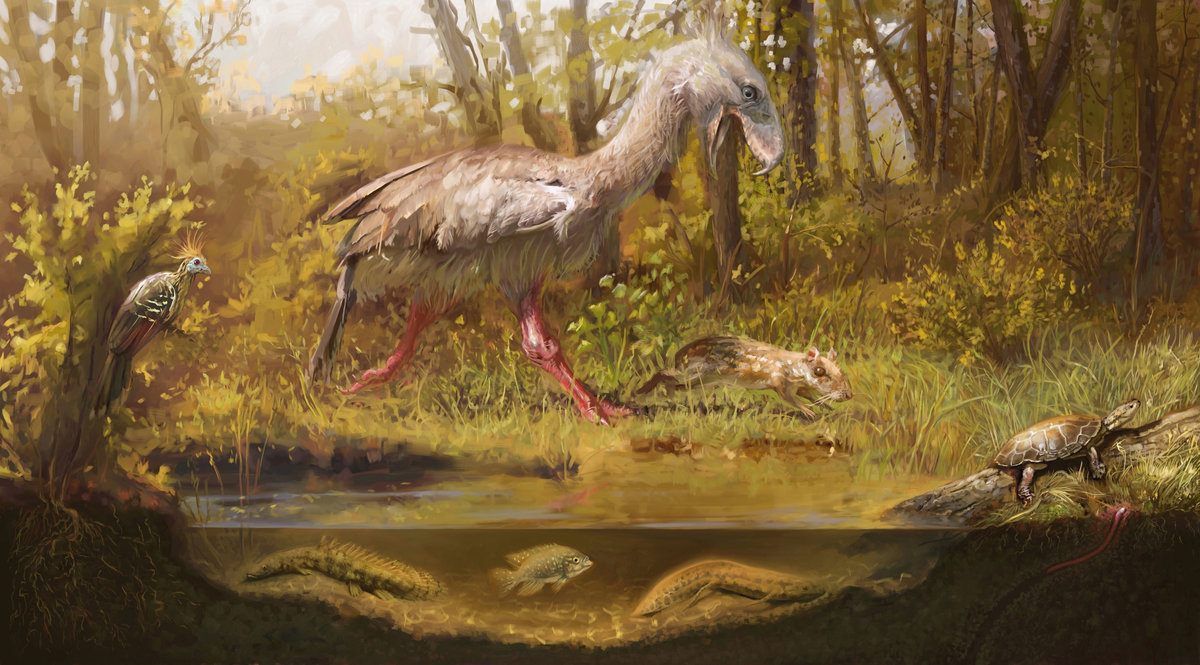
Notable creatures
- Mammals
- Andrewsarchus, the largest terrestrial mammalian carnivore to ever live (how’s that for an overly specific category?)
- Ambulocetus, a transitional whale
- Basilosaurus, undoubtedly a whale
- Paraceratherium, a giant hornless rhinoceros and the largest terrestrial mammal to ever live
- Chalicotherium, a knuckle-walking horse thing
- Hesperocyon, an early dog
- Eosimias, an early primate
- Eohippus, an early horse
- Reptiles
- Gastornis, a large carnivorous “terror bird” pretending to be a tyrannosaur
- Titanoboa, the largest snake to ever live
What did our ancestors look like?
In the early Paleogene, our ancestors looked like Eosimias (meaning “dawn monkey”), an early primate. Later in the same period, the ancestors of monkeys split from those of apes; an example of an early ape is Saadanius.
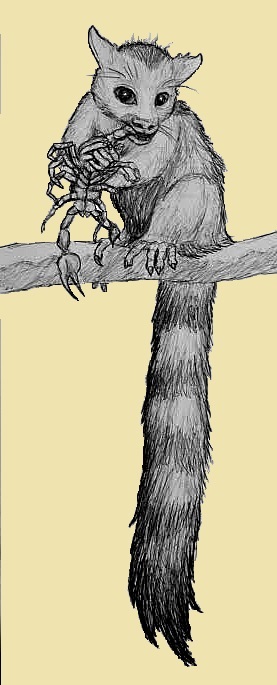
The Neogene Period: First hominins (23-2.58 million years ago)
During the Neogene, pretty much all the animal groups we’re currently familiar with evolved to their modern forms. South America, which had been an island for a long time, collided with North America, forming the Isthmus of Panama and setting off the Great American Biotic Interchange (known to its friends as GABI), where animals crossed from North to South America and vice versa and many of the South American groups went extinct. The formation of Panama also prevented water from flowing between the Atlantic and Pacific oceans, which contributed to overall global cooling and helped to trigger the Ice Ages.
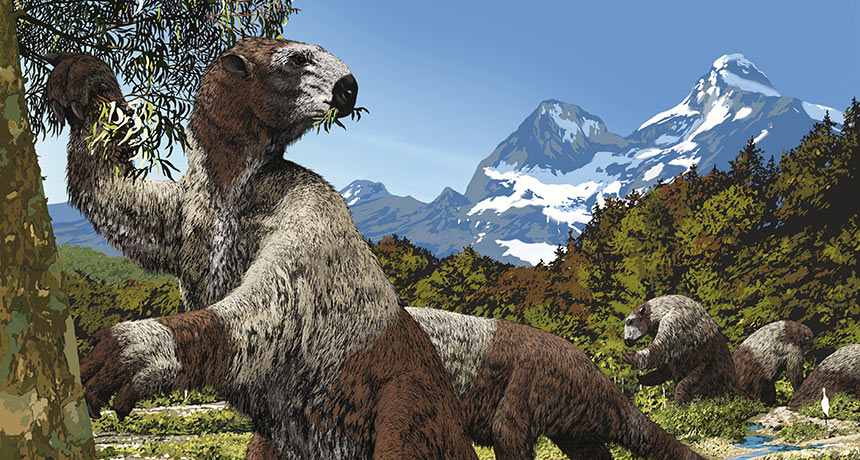
Notable creatures
- Mammals
- Ardipithecus
- Australopithecus, “Lucy”
- Gigantopithecus, a giant ape
- Mastodon
- Megatherium, a giant ground sloth
- Homotherium, a scimitar-toothed cat
- Borophagus, a bone-crushing dog
- Reptiles
- Argentavis, a giant flying bird
- Brontornis, a giant terror bird
- Stupendemys, a giant sea turtle
- Megalochelys, a giant tortoise
- Megalodon, a giant shark
What did our ancestors look like?
Our last common ancestor with chimpanzees resembled Sahelanthropus, a Miocene-epoch great ape that may have been bipedal. Later in the Neogene, hominids who were definitely bipedal evolved, such as Australopithecus.
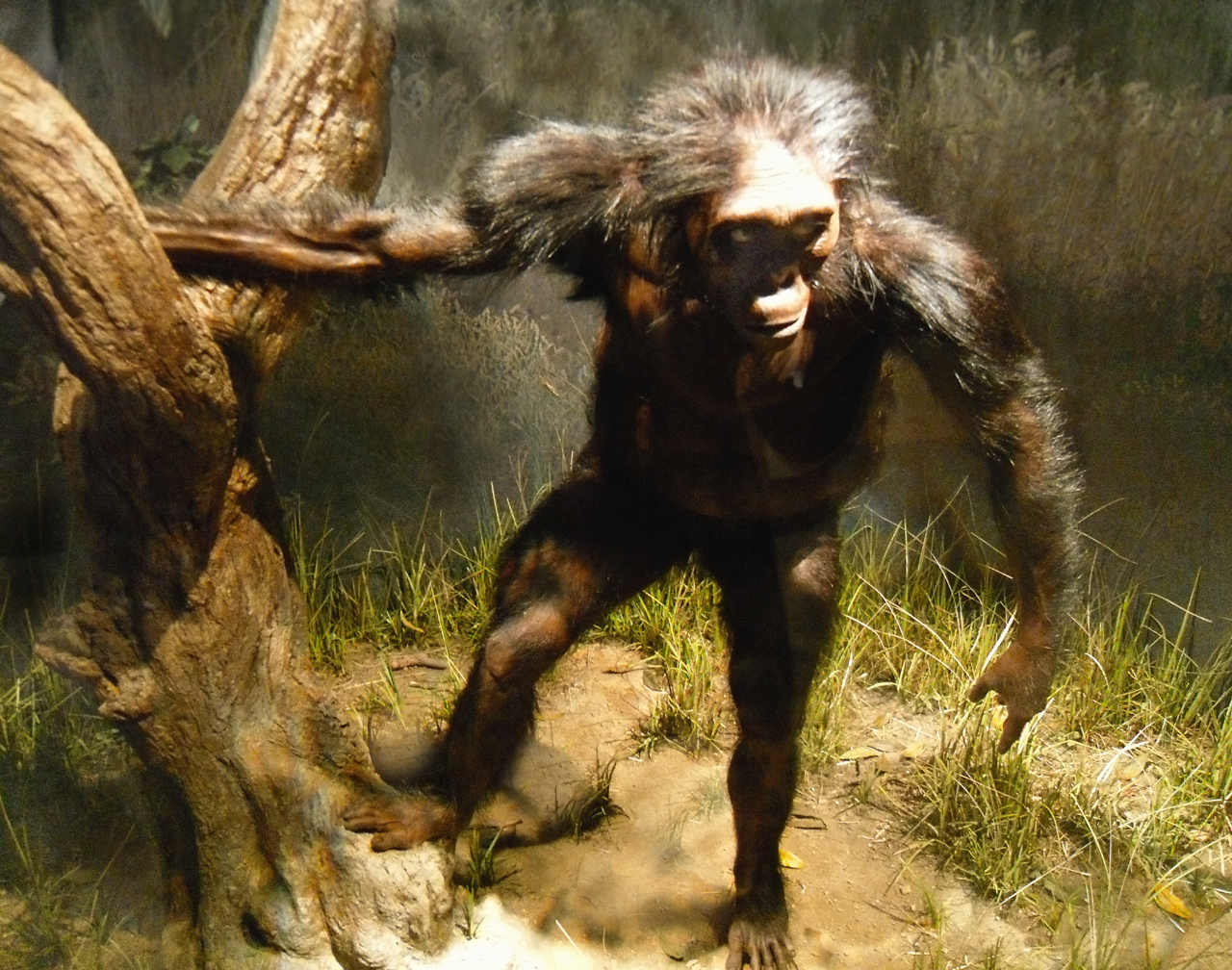
The Quaternary Period: Ice Age and Beyond (2.58 million years ago - present)
The first epoch of the Quaternary period, the Pleistocene, is also known as the Ice Age because it spans a time of repeated, planet-scale glaciations. Modern humans arose at the end of the Pleistocene and lived alongside other types of humans such as Neanderthals, Denisovans, and Homo erectus. At the end of the Pleistocene, global warming caused most of the megafauna (large animals) to go extinct, leaving the world looking basically as it does today.
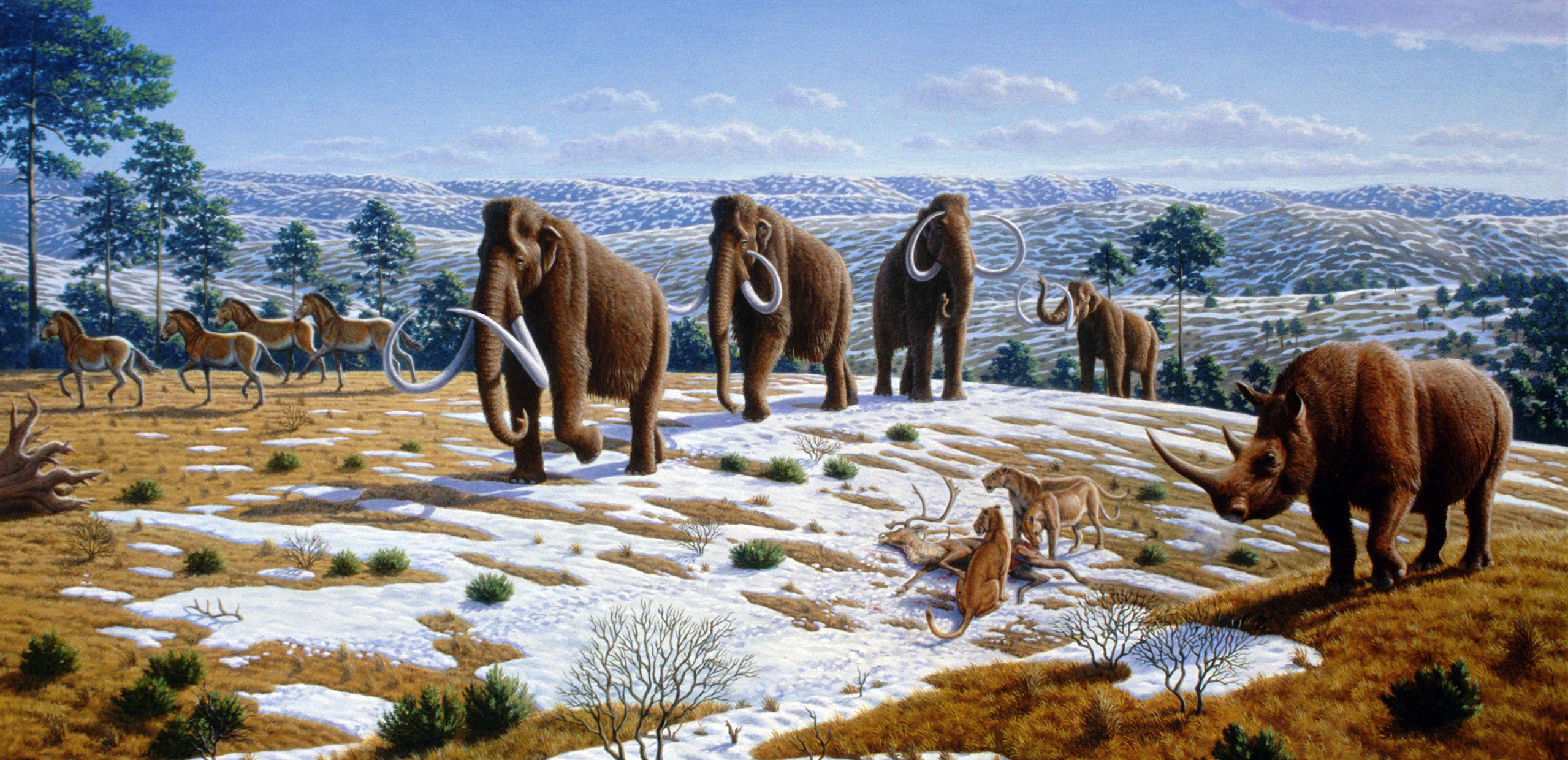
Notable creatures
- Mammals
- Humans
- Smilodon, the saber-toothed tiger
- Arctotherium, a giant bear
- Glyptodon, a giant armadillo with a tail club
- Aurochs, a fierce wild cow
- Dire wolf
- Reptiles
- Moa, a large ratite from New Zealand, extinct around 1400 CE
- Haast’s eagle, a giant eagle from New Zealand, extinct around 1400 CE because it relied on moa for food
- Elephant bird, a super-heavy ratite from Madagascar, extinct around 1200 CE, which laid the largest eggs of any land animal
- Megalania, a giant monitor lizard
What did our ancestors look like?
Anatomically modern humans arose during this period, but continued to interbreed with Neanderthals and Denisovans until the latter two groups went extinct around 40,000 and 15,000 years ago, respectively.

